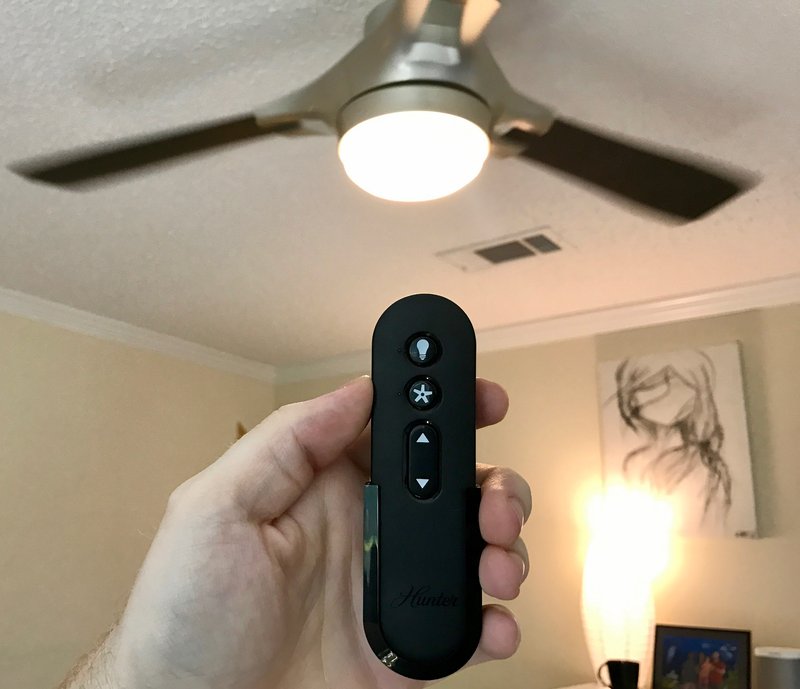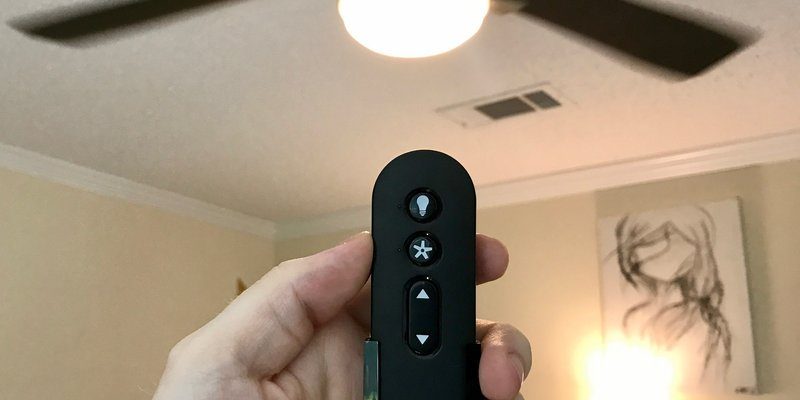
Hunter is a big name in ceiling fans. You’ll find their fans spinning in cozy bedrooms, sunrooms, and living rooms all over the country. Their remotes are pretty handy for basic controls—lights, speed, maybe even a reverse button. But what about that next level—controlling your fan with Alexa, Google Home, or your phone? Let me walk you through what’s possible, what’s not, and how you can make your Hunter fan more “smart” if that’s what you’re after.
Understanding Hunter Ceiling Fan Remotes: Standard Features and Limitations
First things first: not all Hunter fan remotes are created equal. Most Hunter ceiling fans come with a simple handheld remote. Usually, you get basic functions—a button for speed (low, medium, high), another for the light, and sometimes a dimmer. Some models toss in a reverse function or a timer, but generally, you’re looking at straightforward, battery-powered remotes.
These remotes use radio-frequency (RF) to communicate with the fan. That’s why you don’t have to point them like a TV remote. Pretty convenient, but also a bit “closed off”—they’re not Wi-Fi or Bluetooth enabled right out of the box. This means **standard Hunter remotes aren’t directly compatible with smart home hubs** like Alexa or Google Home.
Here’s the thing: if you’ve lost your remote, need to reset or re-pair it, or the battery keeps dying, you’re probably already familiar with the small challenges that come with these remotes. In these cases, the idea of upgrading to something smarter becomes even more appealing.
Which Hunter Remotes Offer Smart Home Integration?
Honestly, most Hunter fans come with basic remotes that can’t talk to smart home systems by themselves. But Hunter has moved with the times and released specific models and *accessories* designed for this crowd. Enter Hunter’s **SimpleConnect®** fans and smart control kits. These fan models (look for “Wi-Fi” or “SimpleConnect” on the box) are made to play with your home’s Wi-Fi network.
With a SimpleConnect fan, you don’t need a universal remote, extra code to pair, or to mess around with batteries as much. The fan connects to your phone via Hunter’s proprietary app, and from there, you can link it to Alexa, Google Assistant, or even Apple HomeKit. Suddenly, “turn on the bedroom fan” is as easy as asking your smart speaker.
But—and this is a big but—**this smart integration only works if your fan and remote were built for it**. If you just have a regular Hunter remote, you’ll need to add extra hardware, like a smart wall switch or a universal Wi-Fi remote kit, to get this kind of control.
How Does Smart Home Integration Work with Hunter Fans?
Let me explain how this integration actually happens. When you have a compatible Hunter fan (like those with SimpleConnect), the fan has built-in Wi-Fi. Instead of only listening for the RF signals from your handheld remote, it can now receive commands over your home network.
Here’s what usually happens in practice:
- You install the Hunter fan following the instructions (which usually means syncing the remote as usual—pair, code, battery, the whole deal).
- You download the Hunter app on your phone and connect the fan to your Wi-Fi. This process usually involves pressing a “pair” button on the remote or the fan itself and then following on-screen instructions to sync the fan to your network.
- Once the fan is part of your Wi-Fi network, you link it to Alexa, Google Assistant, or Apple HomeKit. Now, voice commands and app controls are ready to go.
All controls—speed, light, on/off—now go through your phone and smart home devices, but you can still use the original remote if you want to. This “dual control” is pretty handy when your phone’s in the other room or the Wi-Fi acts up.
Troubleshooting Common Smart Integration Issues
You might be wondering, “What could go wrong?” Frankly, plenty. Setting up smart home features isn’t always plug-and-play—especially if you’re mixing old remotes with new tech.
Sometimes, pairing the fan with your Wi-Fi gets stuck. Maybe the fan doesn’t show up in the app, or your smart speaker doesn’t recognize it. Often, it comes down to one of these:
- Outdated firmware: Make sure your Hunter app and fan firmware are up to date.
- Wi-Fi frequency: Most smart fans only work on 2.4 GHz Wi-Fi—not 5 GHz. Check your router settings if things won’t sync.
- Resetting the fan: Sometimes you need to reset or “forget” the fan in the app and re-pair everything, much like rebooting your computer.
- Interference: RF and Wi-Fi signals can get muddled, especially if you have multiple smart devices nearby.
If all else fails, Hunter’s customer support actually isn’t bad. But be patient—sometimes a simple reset or replacing the batteries in your remote is all it takes.
Can You Upgrade Standard Hunter Remotes to Support Smart Home Features?
Here’s where things get interesting. If your ceiling fan didn’t come with smart features, you still have options. Several third-party kits claim to make “dumb” fans smart. These kits usually include a Wi-Fi enabled receiver you install in the fan canopy and a new universal remote.
The process usually goes like this:
- Turn off the power (seriously, don’t skip this step—you don’t want a shocking surprise).
- Open up the fan canopy. This is where the remote’s receiver usually sits.
- Swap out the old receiver for the new Wi-Fi enabled one. Most kits color-code the wires for beginners, but if you’re uncomfortable, get an electrician.
- Pair the new receiver with your phone and, if needed, sync the replacement remote.
After that, you control the fan using your phone and your smart home system. Not every smart kit will give you full light-dimming or reverse features, but most cover the basics. And yes, you’ll likely need to re-sync if there’s ever a power outage or battery issue.
One word of caution: always check if the kit is compatible with Hunter fans—and whether using it affects your fan’s warranty. Not all brands play nice together.
Universal Remotes vs. Hunter’s Smart Remotes: What’s the Difference?
It might sound tempting to grab any “universal” smart remote off Amazon, but there are real differences. **Universal remotes** are often designed to work with many brands, but they sometimes require you to enter a special code (remember programming old VCRs?). Sometimes, basic controls like speed or lights work fine, but unique features—like Hunter’s dimming or reverse—don’t always make the leap.
Hunter’s smart remotes, or their official SimpleConnect app, are built to cover every feature of their fans. If you value smooth integration and want to avoid a sync or reset headache, sticking with Hunter’s own compatible accessories makes life easier.
That’s not to say universal remotes are useless. In fact, some Wi-Fi-enabled universal kits do the trick for older Hunter fans that don’t have built-in smart features. Just expect a little extra setup, and check twice for compatibility.
Comparing Hunter Smart Fan Integration with Other Brands
You might notice some brands go harder on the smart features than Hunter. For example, other big brands offer fans with built-in Alexa support, built-in Zigbee, or even direct integration with Samsung SmartThings. Hunter’s smart system is a bit more “closed”—you’ll mostly use their app first, then link to your chosen smart assistant.
In my experience, Hunter’s integration isn’t the fastest on the market, but it’s reliable once set up. If you’re deep into a specific smart ecosystem, double-check which brands offer native support. Sometimes, paying a little more upfront for a fan with built-in voice control saves a lot of syncing, resetting, and troubleshooting down the road.
Practical Tips: Getting the Most Out of Your Hunter Fan Remote
Here’s the thing: no matter how smart your fan gets, you’ll probably still use the remote sometimes. A couple quick tips:
- **Keep a spare battery**—dead batteries are the
- **Write down your syncing code** if you install a universal kit; it’ll save you a headache after a power outage.
- **Don’t toss your original remote**—even if you’re pairing with your phone, a remote is handy as a backup.
- **Update the Hunter app** regularly for bug fixes and better smart home compatibility.
If you notice weird glitches (lights flicker, fan speeds seem off), try resetting the fan and remote. Most Hunter remotes have a small “reset” or “pair” button—pressing that can solve many issues.
Smart home integration with Hunter ceiling fan remotes is a bit like adding Wi-Fi to a classic record player. The potential is there, but it depends on your specific model and whether you’re willing to tinker or upgrade. If you buy a new Hunter SimpleConnect fan, you’ll have a smooth ride with Alexa, Google Home, or Apple HomeKit. Older fans and standard remotes? You’ll need a compatible smart kit, a bit of patience, and maybe a screwdriver.
Either way, the dream of controlling your ceiling fan from your couch—or with just your voice—isn’t far off, even if it takes an extra step or two. Smart homes keep getting smarter, and even ceiling fans are joining the party. If you’re ready to take the plunge, just make sure to match the right gear with your fan, and don’t be afraid to ask for help. You’ll be enjoying hands-free comfort in no time.
